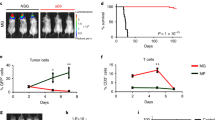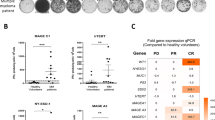Abstract
Cytotoxins directed to interleukin-4 receptors have shown to mediate relatively selective cytotoxicity against a variety of human cancer cells in vitro and in vivo. In an ongoing Phase I clinical trial, a recombinant protein comprised of circularly permuted IL-4 fused to a mutated form of Pseudomonas exotoxin (the fusion protein termed IL-4(38-37)-PE38KDEL or cpIL4-PE) has shown antitumour activity against malignant glioma. Human medulloblastomas are neuroectodermal tumours that occur in children and have a poor prognosis. The goal of this study was to determine whether human medulloblastoma derived cell lines express interleukin-4 receptor and whether interleukin-4 receptor expression is accompanied by sensitivity to cpIL4-PE. Medulloblastoma cell lines express interleukin-4 receptor at the protein and mRNA levels as determined by binding, indirect immunofluorescence and RT–PCR studies. These cells expressed IL-4Rα (also known as IL-4Rβ) and IL-13Rα1 (also known as IL-13Rα′) chains, however common γc, a component of the interleukin-4 receptor system in immune cells was not detected. Consistent with the expression of IL-4R, cpIL4-PE was found to be highly and specifically cytotoxic to four of five medulloblastoma cell lines. Susceptibility of medulloblastoma cell lines to cpIL4-PE seemed to correlate closely to the functional IL-4 binding sites in general as demonstrated by 125I-IL-4 binding, but did not seem to correlate with mRNA or cell surface immunoreactive receptor protein expression. The sensitivity of medulloblastoma cells to cpIL4-PE could be eliminated by concurrent incubation with IL-4 or IL-13, but not with IL-2. None of these cell lines showed any change in proliferation upon treatment with exogenous IL-4. These studies establish the interleukin-4 receptor as a medulloblastoma-associated target for possible tumour-directed cancer therapy. Further studies are warranted to investigate interleukin-4 receptor expression in primary medulloblastoma tumours and sensitivity to cpIL-4PE in vitro and in vivo.
This is a preview of subscription content, access via your institution
Access options
Subscribe to this journal
Receive 24 print issues and online access
$259.00 per year
only $10.79 per issue
Buy this article
- Purchase on Springer Link
- Instant access to full article PDF
Prices may be subject to local taxes which are calculated during checkout





Similar content being viewed by others
References
Hoon DS, Banez M, Okun E, Morton DL, Irie RF (1991) Modulation of human melanoma cells by interleukin-4 and in combination with gamma-interferon or alpha-tumor necrosis factor. Cancer Res 51: 2002–2008
Husain SR, Behari N, Kreitman RJ, Pastan I, Puri RK (1998) Complete regression of established human glioblastoma tumor xenograft by interleukin-4 toxin therapy. Cancer Res 58: 3649–3653
Husain SR, Gill PS, Kreitman RJ, Pastan I, Puri RK (1997) Interleukin-4 receptor expression on AIDS- associated Kaposi's Sarcoma cells and their targeting by a chimeric protein comprised of circularly permutaed Interleukin-4 and Pseudomonas exotoxin. Mol Medicine 3: 327–338
Husain SR, Kreitman RJ, Pastan I, Puri RK (1999) Interleukin-4 receptor-directed cytotoxin therapy of AIDS-associated Kaposi's sarcoma tumors in xenograft model [see comments]. Nat Med 5: 817–822
Joshi BH, Plautz GE, Puri RK (2000) Interleukin-13 receptor alpha chain: a novel tumor-associated transmembrane protein in primary explants of human malignant gliomas. Cancer Res 60: 1168–1172
Joshi BH, Leland P, Asher A, Prayson RA, Varricchio F, Puri RK (2001) In situ expression of Interleukin-4 (IL-4) receptors in human brain tumors and cytotoxicity of a recombinant IL-4 cytotoxin in primary glioblastoma cell cultures. Cancer Res 61: 8058–8061
Kawakami K, Leland P, Puri RK (2000) Structure, function, and targeting of interleukin 4 receptors on human head and neck cancer cells. Cancer Res 60: 2981–2987
Keles GE, Berger MS, Srinivasan J, Kolstoe DD, Bobola MS, Silber JR (1995) Establishment and characterization of four human medulloblastoma-derived cell lines. Oncol Res 7: 493–503
Kreitman R, Puri RK, Pastan I (1994) A circularly permutated recombinant interleukin 4 toxin with increased activity. Proc Natl Acad Sci USA 91: 6889–6893
Kreitman RJ, Puri RK, McPhie P, Pastan I (1995a) Circularly permuted interleukin 4 retains proliferative and binding activity. Cytokine 7: 311–318
Kreitman RJ, Puri RK, Pastan I (1995b) Increased antitumor activity of a circularly permuted interleukin 4-toxin in mice with interleukin 4 receptor-bearing human carcinoma. Cancer Res 55: 3357–3363
Leland P, Obiri N, Aggarwal BB, Puri RK (1995) Suramin blocks binding of interleukin-4 to its receptors on human tumor cells and interleukin-4-induced mitogenic response. Oncol Res 7: 227–235
Leland P, Taguchi J, Husain SR, Kreitman RJ, Pastan I, Puri RK (2000) Human breast carcinoma cells express type II IL-4 receptors and are sensitive to antitumour activity of a chimeric IL-4-Pseudomonas exotoxin fusion protein in vitro and in vivo. Mol Med 6: 165–178
Liu H, Prayson RA, Estes ML, Drazba JA, Barnett GH, Bingaman W, Liu J, Jacobs BS, Barna BP (2000) In vivo expression of the interleukin 4 receptor alpha by astrocytes in epilepsy cerebral cortex. Cytokine 12: 1656–1661
Murata T, Noguchi PD, Puri RK (1995) Receptors for interleukin (IL)-4 do not associate with the common gamma chain, and IL-4 induces the phosphorylation of JAK2 tyrosine kinase in human colon carcinoma cells. J Biol Chem 270: 30829–30836
Murata T, Obiri NI, Debinski W, Puri RK (1997a) Structure of IL-13 receptor: analysis of subunit composition in cancer and immune cells. Biochem Biophys Res Commun 238: 90–94
Murata T, Obiri NI, Puri RK (1997b) Human ovarian-carcinoma cell lines express IL-4 and IL-13 receptors: comparison between IL-4- and IL-13-induced signal transduction. Int J Cancer 70: 230–240
Murata T, Obiri NI, Puri RK (1998a) Structure of and signal transduction through interleukin-4 and interleukin-13 receptors. (review) Int J Mol Med 1: 551–557
Murata T, Taguchi J, Puri RK (1998b) Interleukin-13 receptor alpha′ but not alpha chain: a functional component of interleukin-4 receptors. Blood 91: 3884–3891
Myers JN, Yasumura S, Suminami Y, Hirabayashi H, Lin W, Johnson JT, Lotze MT, Whiteside TL (1996) Growth stimulation of human head and neck squamous cell carcinoma cell lines by interleukin 4. Clin Cancer Res 2: 127–135
Obiri NI, Hillman GG, Haas GP, Sud S, Puri RK (1993) Expression of high affinity interleukin-4 receptors on human renal cell carcinoma cells and inhibition of tumour cell growth in vitro by interleukin-4. J Clin Invest 91: 88–93
Obiri NI, Leland P, Murata T, Debinski W, Puri RK (1997) The IL-13 receptor structure differs on various cell types and may share more than one component with IL-4 receptor. J Immunol 158: 756–764
Oshima Y, Joshi BH, Puri RK (2000) Conversion of interleukin-13 into a high affinity agonist by a single amino acid substitution. J Biol Chem 275: 14375–14380
Puri R, Leland P, Kreitman R, Pastan I (1994) Human neurological cancer cells express interleukin-4 (IL-4) receptors which are targets for the toxic effects of IL4-Pseudomonas exotoxin chimeric protein. Int J Cancer 58: 574–581
Puri RK (1995) Structure and function of interleukin-4 and its receptor. In Cytokines: Interleukins and their receptors Kurzrock R, Talpaz M (eds). pp 143–185, Norwell, MA: Kluwer Academic Publishers
Puri RK, Hoon DS, Leland P, Snoy P, Rand RW, Pastan I, Kreitman RJ (1996a) Preclinical development of a recombinant toxin containing circularly permuted interleukin 4 and truncated Pseudomonas exotoxin for therapy of malignant astrocytoma. Cancer Res 56: 5631–5637
Puri RK, Leland P, Obiri NI, Husain SR, Mule J, Pastan I, Kreitman RJ (1996b) An improved circularly permuted interleukin 4-toxin is highly cytotoxic to human renal cell carcinoma cells. Introduction of gamma c chain in RCC cells does not improve sensitivity. Cell Immunol 171: 80–86
Puri RK, Ogata M, Leland P, Feldman GM, FitzGerald D, Pastan I (1991) Expression of high-affinity interleukin 4 receptors on murine sarcoma cells and receptor-mediated cytotoxicity of tumor cells to chimeric protein between interleukin 4 and Pseudomonas exotoxin. Cancer Res 51: 3011–3017
Rand RW, Kreitman RJ, Patronas N, Varricchio F, Pastan I, Puri RK (2000) Intratumoral administration of recombinant circularly permuted interleukin-4-Pseudomonas exotoxin in patients with high-grade glioma [In Process Citation]. Clin Cancer Res 6: 2157–2165
Stevens MC, Cameron AH, Muir KR, Parkes SE, Reid H, Whitwell H (1991) Descriptive epidemiology of primary central nervous system tumours in children: a population-based study. Clin Oncol (R Coll Radiol) 3: 323–329
Toi M, Bicknell R, Harris AL (1992) Inhibition of colon and breast carcinoma cell growth by interleukin-4. Cancer Res 52: 275–279
Topp MS, Koenigsmann M, Mire-Sluis A, Oberberg D, Eitelbach F, Marschall ZV, Notter M, Reufi B, Stein H, Thiel E, Berdel WE (1993a) Interleukin 4 inhibits growth of a human lung tumor cell line in vitro and has therapeutic activity against xenografts of this cell line in vivo. Int J Oncol 3: 167–170
Topp MS, Koenigsmann M, Mire-Sluis A, Oberberg D, Eitelbach F, von Marschall Z, Notter M, Reufi B, Stein H, Thiel E (1993b) Recombinant human interleukin-4 inhibits growth of some human lung tumor cell lines in vitro and in vivo Blood. 82: 2837–2844
Acknowledgements
We thank Drs SR Husain, Koji Kawakami and Mariko Kawakami for suggestions and helpful comments. We also thank Mr Christopher Vargas and his team members of Scientific Computing Resource Center, Center for Information Technologies, NIH for their help in fluorescence image processing. These studies were conducted as a part of collaboration between the FDA and Neurocrine BioSciences under a CooperativeResearch and Development Agreement (CRADA).
Author information
Authors and Affiliations
Corresponding author
Rights and permissions
About this article
Cite this article
Joshi, B., Leland, P., Silber, J. et al. IL-4 receptors on human medulloblastoma tumours serve as a sensitive target for a circular permuted IL-4-Pseudomonas exotoxin fusion protein. Br J Cancer 86, 285–291 (2002). https://doi.org/10.1038/sj.bjc.6600034
Received:
Revised:
Accepted:
Published:
Issue Date:
DOI: https://doi.org/10.1038/sj.bjc.6600034
Keywords
This article is cited by
-
Identification of a novel role of IL-13Rα2 in human Glioblastoma multiforme: interleukin-13 mediates signal transduction through AP-1 pathway
Journal of Translational Medicine (2018)
-
NY-ESO-1- and survivin-specific T-cell responses in the peripheral blood from patients with glioma
Cancer Immunology, Immunotherapy (2018)



